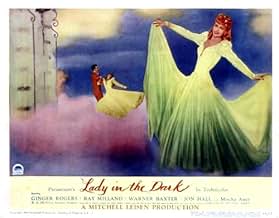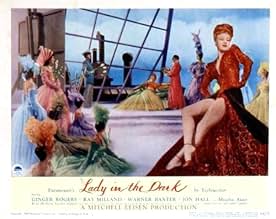AVALIAÇÃO DA IMDb
5,9/10
610
SUA AVALIAÇÃO
Adicionar um enredo no seu idiomaLiza Elliott, "Allure" magazines editor-in-chief, suffers from headaches and continuous daydreams and undergoes psychoanalysis to determine why.Liza Elliott, "Allure" magazines editor-in-chief, suffers from headaches and continuous daydreams and undergoes psychoanalysis to determine why.Liza Elliott, "Allure" magazines editor-in-chief, suffers from headaches and continuous daydreams and undergoes psychoanalysis to determine why.
- Direção
- Roteiristas
- Artistas
- Indicado a 3 Oscars
- 1 vitória e 3 indicações no total
Avaliações em destaque
A Technicolor spectacular, with costumes and wonderful sets to match, but the story isn't much, mostly what you might expect to read in Popular Psychoanalysis magazine.
Best are the dream and reverie sequences, especially the trial in the circus ring. These are where the singing and dancing is, but there is not much and what little there is is not very exciting.
Best are the dream and reverie sequences, especially the trial in the circus ring. These are where the singing and dancing is, but there is not much and what little there is is not very exciting.
For just three minutes towards the end of this overproduced travesty of Moss Hart's 1941 Broadway hit we finally get a hint of what might have been, when Ginger Rogers (a coarse substitute for Gertrude Lawrence, who declined to submit to the indignity of testing for the part) is finally allowed to sing a song from Kurt Weill & Ira Gershwin's acclaimed score - the magnificent 'Saga of Jenny' - the only song from the original production to make it into the film. (The flashbacks to her childhood and youth that follow actually manage to be quite touching.)
At $2.6million the most expensive film yet made by Paramount, at the box office the studio received a handsome return on its investment. But the hectoring misogyny that makes this film almost unwatchable today is probably just one reason that nobody has ever bothered to do a decent restoration of the film, so we really don't get the full benefit of the Oscar-nominated Technicolor photography and art direction that wowed critics and audiences back in 1944.
Ray Milland is excruciatingly misused as a charmless boor who Ginger is required by the script eventually to fall into the arms of (Cary Grant might just have pulled it off), and her rejection of Warner Baxter and Jon Hall for being insufficiently Alpha is just another twist of the knife of the already unpleasant sexual politics of this piece. (Ginger, by the way, actually looks pretty cool to my eyes in her 'unattractive' mannish suits.)
But at least we don't get Danny Kaye's mugging from the Broadway original as the camp fashion photographer Russell Paxton (Mischa Auer is a far more agreeable substitute), and are spared his 'hilarious' patter song 'Tschaikowsky (and Other Russians)'.
Mary Phillips does her best in an underwritten part (as indeed are most of them). Edward Fielding, by the way, who plays Ginger's physician in the opening sequence, also appeared uncredited as Dr. Edwardes in the dream sequence of Hitchcock's 'Spellbound' (1945), Hollywood's other high profile exercise in cod psychology from this era.
At $2.6million the most expensive film yet made by Paramount, at the box office the studio received a handsome return on its investment. But the hectoring misogyny that makes this film almost unwatchable today is probably just one reason that nobody has ever bothered to do a decent restoration of the film, so we really don't get the full benefit of the Oscar-nominated Technicolor photography and art direction that wowed critics and audiences back in 1944.
Ray Milland is excruciatingly misused as a charmless boor who Ginger is required by the script eventually to fall into the arms of (Cary Grant might just have pulled it off), and her rejection of Warner Baxter and Jon Hall for being insufficiently Alpha is just another twist of the knife of the already unpleasant sexual politics of this piece. (Ginger, by the way, actually looks pretty cool to my eyes in her 'unattractive' mannish suits.)
But at least we don't get Danny Kaye's mugging from the Broadway original as the camp fashion photographer Russell Paxton (Mischa Auer is a far more agreeable substitute), and are spared his 'hilarious' patter song 'Tschaikowsky (and Other Russians)'.
Mary Phillips does her best in an underwritten part (as indeed are most of them). Edward Fielding, by the way, who plays Ginger's physician in the opening sequence, also appeared uncredited as Dr. Edwardes in the dream sequence of Hitchcock's 'Spellbound' (1945), Hollywood's other high profile exercise in cod psychology from this era.
"Lady in the Dark" is a curiosity. The circus sequence with "The Saga of Jenny" gives a taste of what the movie version of the Broadway show might have been like (as other commentators have noted, the song is the sole survivor of the Broadway score by Weill and Gershwin, aside from snatches of "My Ship" and "Suddenly it's Spring", and a verse from "Once Life to Life" which Ginger Rogers recites). Ginger is a knockout, even in her "plain" business suits. The visual design is so rich you could swim in it- it was lovely to see the 40s magazine design as well as the sets. And the costumes! The sequin lined mink skirt is stunning, and so is the gown in the wedding sequence. The psychoanalysis storyline is well handled for a movie made in this period when analysis was strange and frightening to the audience. However, what could have been an exquisite soufflé is let down by the bizarre decision to cut all but one of the numbers and the development of the plot. It suggests that women are miserable in business suits and are far happier wearing frou frou gowns and being "dominated" by men (its terminology, not mine). I will say in the plot's defense (if I may take Ray Milland's part in the circus sequence for a moment) that it doesn't have Ginger pairing off with irresistible but insecure movie star Randy Curtis. When she announced that she was going to marry him and give up her job I yelled out, "You'll be sorry!" The writers recognize that Randy and staying home to be a housewife (even a Hollywood one) would bore Ginger's character out of her tree. Her sparring colleague is a far better choice, and there's a hint in the final that perhaps neither Ray or Ginger will dominate the other, but be partners in running the magazine (they're both overwhelmed with enthusiasm for it). But this hint of equality isn't enough to redeem Ray's earlier nastiness to Ginger, or the tone of misogyny. The movie still comes down with a thud, like Ginger at the end when Ray takes her chair.
Liza (Ginger Rogers) is the editor of a magazine who can no longer make decisions. She suffers headaches because she is highly strung about work and she has a love life that she is not comfortable with. Through psychoanalysis with Dr Brooks (Barry Sullivan), she unravels her troubles by recounting 3 dream sequences. Can she regain her decisiveness?
This film is a bit girly in that it concerns one woman's journey to discover lost memories and understand her behaviours. It has great colour, good costumes and it's well acted with a spattering of humour throughout. The bulk of the film comes in the form of dream sequences which are musical, colourful and surreal. The 2nd sequence has a pointless dance scene which drags on a bit but overall the dreams are entertaining. The rest of the film follows the romances that Liza has alongside her role as a tough "boss lady". The film is fun and has a happy ending.
This film is a bit girly in that it concerns one woman's journey to discover lost memories and understand her behaviours. It has great colour, good costumes and it's well acted with a spattering of humour throughout. The bulk of the film comes in the form of dream sequences which are musical, colourful and surreal. The 2nd sequence has a pointless dance scene which drags on a bit but overall the dreams are entertaining. The rest of the film follows the romances that Liza has alongside her role as a tough "boss lady". The film is fun and has a happy ending.
I found this to be moderately enjoyable and much smoother than I was expecting, after reading of all the problems in making it and the cutting of musical numbers from the original score. Would love to see it as was originally intended (in a restored DVD version).
The psychoanalysis as it unfolds is interesting and makes sense, except to the point of the woman needing to be dominated by the man. I don't know if this was dictated by the culture of the time, but all that was really needed was for Liza to know she needed to give time to gaining fulfillment in a relationship (without the aspect of dominance) and not be so driven work wise (her substitute), and it would have come out without the nasty taste it leaves now (in regards to this aspect of the film).
Director Mitchell Leisen dealt with this sort of theme also (without the psychoanalysis) in Take a Letter Darling which was funnier and sharper, and without the need for the man to have to dominate the woman.
Some of the visual imagery in the dream sequences is a lot of fun and apparently a lot of care was put into their production.
As well the movie seems like it is a 50s product but that could just be the colour.
The psychoanalysis as it unfolds is interesting and makes sense, except to the point of the woman needing to be dominated by the man. I don't know if this was dictated by the culture of the time, but all that was really needed was for Liza to know she needed to give time to gaining fulfillment in a relationship (without the aspect of dominance) and not be so driven work wise (her substitute), and it would have come out without the nasty taste it leaves now (in regards to this aspect of the film).
Director Mitchell Leisen dealt with this sort of theme also (without the psychoanalysis) in Take a Letter Darling which was funnier and sharper, and without the need for the man to have to dominate the woman.
Some of the visual imagery in the dream sequences is a lot of fun and apparently a lot of care was put into their production.
As well the movie seems like it is a 50s product but that could just be the colour.
Você sabia?
- CuriosidadesThis was one of the first films to use the word "sex." Ray Milland says, "Rage is a pretty good substitute for sex, isn't it?"
- Citações
Russell Paxton: "This is the end! The absolute end!"
- Cenas durante ou pós-créditosAt the start of the film the Paramount logo is set at night, in the dark.
At the end of the film the Paramount logo is seen at dawn, come into the light.
- ConexõesReferenced in Mini Conto Musical (1946)
- Trilhas sonorasMain Title
Music by James Jimmy Van Heusen and Lyrics by Johnny Burke
Performed by the Paramount Studio Orchestra and Chorus
Principais escolhas
Faça login para avaliar e ver a lista de recomendações personalizadas
- How long is Lady in the Dark?Fornecido pela Alexa
Detalhes
- Data de lançamento
- País de origem
- Idioma
- Também conhecido como
- Lady in the Dark
- Locações de filme
- Empresa de produção
- Consulte mais créditos da empresa na IMDbPro
- Tempo de duração1 hora 40 minutos
- Proporção
- 1.37 : 1
Contribua para esta página
Sugerir uma alteração ou adicionar conteúdo ausente

Principal brecha
By what name was A Mulher que não Sabia Amar (1944) officially released in India in English?
Responda


































